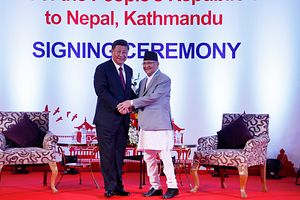Chinese President Xi Jinping made a historic visit two-day to Nepal over the weekend, the first sitting Chinese leader to visit the South Asian nation in more than two decades. Xi was received by Nepalese President Bidhya Devi Bhandari and Prime Minister K. P. Sharma Oli. Leaders from the two countries signed 20 agreements to boost connectivity, trade, economic assistance, and security relations. China and Nepal also agreed to upgrade their ties to a strategic partnership, with Xi vowing to “help Nepal realize its dream of becoming a land-linked country from a land-locked one.”
Among the many deals signed were plans for a 70-kilometer railway connecting Nepal’s capital of Kathmandu and Gyiron in southwestern Tibet and a road tunnel designed to shorten the distance between Kathmandu and the Chinese border. In the lead up to Xi’s visit, a series of other deals were inked, including investments for developing an industrial park, the improvement of roads along the China-Nepal border, and a water supply project.
These echo previous memoranda of understanding between China and Nepal. In June 2018, Prime Minister Oli committed Nepal to building a trans-Himalayan railway between Kathmandu and the Tibetan city of Xigatse. Beijing has been vigorously building railways in its remote southwestern region, including the building of the Sichuan-Tibet railway to link Chengdu and Lhasa. China and Nepal signed a landmark trade and transit agreement in early March 2016. The protocol for the treaty was concluded in September 2018 granting Nepal use of seaport in Tianjin, Shenzhen, Lianyungang and Zhanjiang, as well as dry ports in Lanzhou, Lhasa, and Xigaste. This agreement has the potential to diversify Nepal’s trade routes and access, though the change will likely take time. Nepal’s connection to India stems not only from its geographic proximity but also the high degree of connectivity across its borders.
Both Beijing and Kathmandu stand to benefit from deepening their relationship. For one, Beijing seeks to shore up peaceful ties with its numerous neighboring countries. Nepal had previously expressed support of China’s Belt and Road Initiative (BRI), but the country formally signed onto the initiative in May 2017, just ahead of Beijing’s hosting of the first Belt and Road Forum. The expansion of ties with Nepal have also coincided with greater efforts by Beijing to hasten the development of the Tibet Autonomous Region which borders Nepal along the Himalayan Plateau.
For Kathmandu, Beijing offers an alternative to New Delhi. Nepal has had close ties with its southeastern neighbor, India, which views the small nation as part of its traditional sphere of influence. However, in recent years, China has expanded its influence in Nepal, notably after the devastating earthquake and five-month India “blockade” in 2015. Nepal’s government blamed the economic blockade on India over displeasure of provisions in the new constitution. The blockade exacerbated an already challenging situation for Nepal in its disaster response and rebuilding efforts, inducing fuel, gas, and medicine shortages. These shortages highlighted Nepal’s dependence on border trade with India for access to energy resources and seaports. Around two-thirds of Nepal’s imports come from India, compared to 12 percent from China.
Separately, as the Nepali leader voiced the country’s commitment to the one China policy, Xi also took the opportunity to warn against any action by “separatists” within its territory. “Anyone attempting to split China in any part of the country will end in crushed bodies and shattered bones,” Xi said. The statement came amid ongoing anti-government protests in Hong Kong where protestors have grown increasingly frustrated and clashes with police are on the rise.
Legislation about extradictions in Hong Kong sparked the latest wave of protest. Beijing has also suggested concluding an extradition treaty with Nepal. The treaty was expected to be high on the agenda during Xi’s visit, however negotiations appear to have been tabled, perhaps over cited concerns about Beijing’s attempts to crackdown on Tibetans abroad.

































